

ShowCase is an on-going feature series on Archinect, presenting exciting new work from designers representing all creative fields and all geographies.
We are always accepting nominations for upcoming ShowCase features - if you would like to suggest a project, please send us a message.
Commissioned within a larger city centre regeneration scheme, the John Lewis department store and Cineplex challenge the conventional blank envelopes which typify these buildings and explore ways for them to connect to an urban context.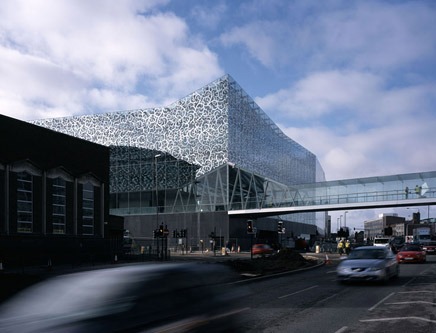
John Lewis Department Store and Cineplex (Photo: Helene Binet)
John Lewis
The department store skin has been designed as a ‘net curtain’ – a patterned fabric which permits interior arrangements to be changed without creating exterior clutter yet providing views and natural light to the interiors. FOA’s pattern design, which resonates with Leicester’s rich textile heritage and John Lewis’s own tradition of producing quality fabrics, is formed of four panels of varying density which meet seamlessly across the envelope, transmitting a fabric affect. Frit in mirror onto two layers of glass curtain wall, the mirrored pattern reflects its context and in doing so, densifies and changes as the sun moves around the building. Viewed frontally from the retail floors, the double façade aligns to allow views out, whilst an oblique view from street level displaces the two patterns and creates a moiré effect, reducing visibility and maximizing privacy performance, and increasing visual complexity. The resulting envelope is a translucent and reflective ‘net curtain’ via which the interior and exterior engage with the context in varying ways.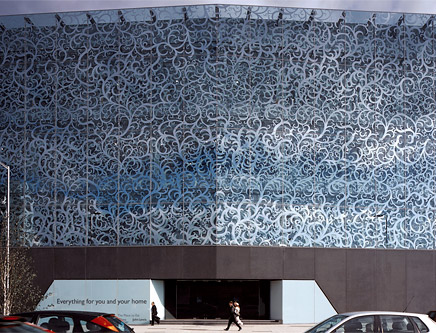
John Lewis Department Store: Entrance (Photo: Satoru Mishima)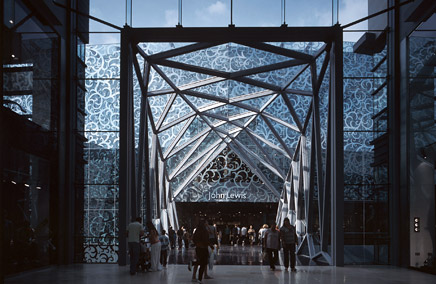
John Lewis Department Store: Entrance (Photo: Satoru Mishima)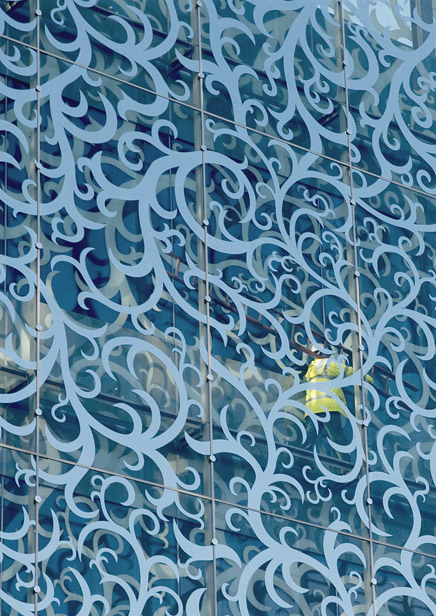
John Lewis Department Store: Façade Detail (Photo: Lube Saveski)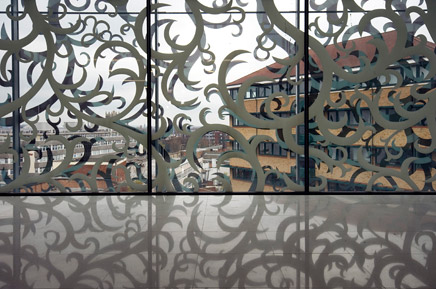
John Lewis Department Store: Interior (Photo: FOA)
Cineplex
The Cineplex needs to be a sealed box, detached from natural light. This part of the building is enveloped in an opaque stainless steel mirror finish rain screen, with pleats along the perimeter introducing intricacy to the enclosure. It is clad in 10,300 small, steel shingles whose thinness transmits a quilted affect and varies and localizes surface reflections. The pleats, shingles and mirror finish provide shadow, texture and color, while the play of light on the surface creates continuously shifting patterns. The opaque envelope is therefore transformed to a ‘theatrical curtain’ whose performance is relative to its exterior.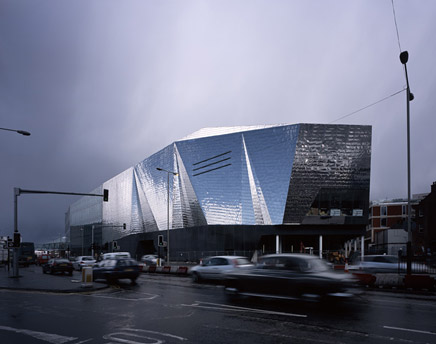
The Cineplex - Street View (Photo: FOA)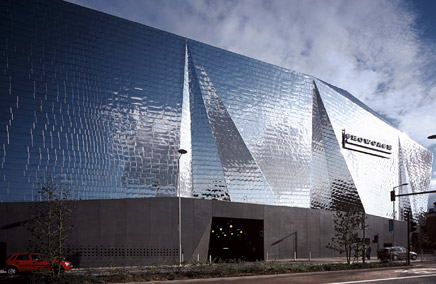
The Cineplex - Street View (Photo: Satoru Mishima)
The Cineplex - Façade Detail (Photo: Helene Binet)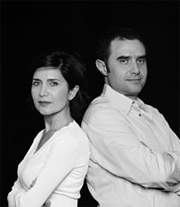
Foreign Office Architects (FOA)
Foreign Office Architects (FOA) was founded in 1995 and has emerged as one of the most innovative practices of architecture and urban design in recent years, known for combining technical innovation with design excellence. FOA's award-winning projects include the Yokohama International Cruise Terminal in Japan, noted for its use of dramatic form, innovative materials, and fascination with the interplay of architecture, landscape, and nature, credited by the Design Museum as a "design sensation alive with bustling urbanity and seaside tranquility". Other award winning projects include the Spanish Pavilion at the Aichi International Expo in Japan; the South-East Coastal Park in Barcelona, Catalonia; the Torrevieja Municipal Theatre and Auditorium, the Technology Centre in Logrono, and the Carabanchel Social Housing in Madrid, Spain; the Highcross development anchor building in Leicester, UK; the Meydan Retail Centre in Istanbul, Turkey; and the Dulnyouk Publishing Headquarters in Paju, South Korea.
FOA's current projects in the UK include Ravensbourne College of Art and Communication in Greenwich, Trinity EC3 office complex in the City of London, two large retail-led schemes in Southampton and Sheffield; the redevelopment of Euston Station and a new Maggie's Centre in Newcastle; in Spain FOA is building the Institute of Legal Medicine in Madrid; in Catalonia, an office complex in Barcelona; in France, Residences for Artists and Researchers in Paris and a large office complex in Toulouse; in the USA, a Museum of Contemporary Art in Cleveland as well as several high-rise residential towers in Korea and Malaysia.
The work of FOA has been widely published and exhibited, and represented Britain at the 8th Venice Architecture Biennale in 2002; the firm has received the Enric Miralles Prize for Architecture, four RIBA World Wide Awards, the 2004 Venice Architecture Biennale Award, and the Charles Jencks Award for Architecture.
Partners
Farshid Moussavi is an architect and educator, and co-founder of Foreign Office Architects (FOA). Since 2006, Farshid Moussavi has been Professor in Practice of Architecture without limit of time at Harvard University. She was trained at Harvard's Graduate School of Design, University College London, and Dundeen University. She has taught at the Academy of Fine Arts in Vienna where she acted as Head of the Architecture Institute, the Architectural Association, the Berlage Institute, and the Hoger Architecture Institute, and in the United States at Harvard, Columbia, and Princeton Universities, and at the University of California at Los Angeles. She has published "The Function of Ornament" in 2006, based on her research and teaching at Harvard.
Professor Moussavi serves as member of design and architecture advisory groups for the British Council and for the Mayor of London's "Design for London" imitative, and previously for the London Development Agency, the RIBA Gold and Presidential Medals, and the Stirling Prize for Architecture. In 2004, she was Chair of Master Jury of the Aga Khan Award for Architecture: since 2005, she has been a member of the Award's Steering Committee.
Alejandro Zaera-Polo is a founding partner of Foreign Office Architects together with Farshid Moussavi, and occupies currently the Berlage Chair in the Technical University of Delft, the Netherlands. Prior to this current role at the TU in Delft, he has been for four years the Dean of the Berlage Institute in Rotterdam, until 2005. Previously he has been also Unit Master at the Architectural Association School of Architecture, and a Visiting Professor at the University of California in L.A., Columbia University in New York, Princeton University, the School Architecture in Madrid and the Yokohama School of Architecture where he currently has an advisory role. He has also been an advisor to several committees, such as the Quality Commission for Architecture in Barcelona City and the advisory Committee for Urban Development of the City of Madrid and is a member of the Urban Age Think Tank of the London School of Economics.
He has published extensively as a critic in professional magazines worldwide, El Croquis, Quaderns, A+U, Arch+ and Harvard Design Magazine amongst them, and contributed to numerous publications, such as The Endless City curated by Ricky Burdett and Dejan Sudjic.
6 Comments
Nice, definitely a different feel from their earlier work. Decorative windows patterns kind of reminds me of an Urban Outfitters display window though
the patterning is nice. how does this effect the interior layout and the programming? what is the organizational pattern of the store and is it different from any other big-box retail structure?
I wish there was some coverage about that in here...
is it just me being dumb or does the artcle forget to mention WHERE this thing is?
bigness:
Leicester, UK. Although the article doesn't explicitly point out the project's location, it qualifies the facade by mentioning in P1 that it:
"...resonates with Leicester’s rich textile heritage..."
bayb you're the beeeest
cheers marlin.
as with every showcase feature, the building's location is mentioned in the brief fact sheet next to the cover picture at the top. ;)
Block this user
Are you sure you want to block this user and hide all related comments throughout the site?
Archinect
This is your first comment on Archinect. Your comment will be visible once approved.